Extended Bio of Daniel Wenger

My life has been filled with exceptional opportunities. When I was a boy, my father built a home and included, as the most important room of the house, the 'hobby room', which was filled with tools, a darkroom and space to create. No doubt my creative side was encouraged to develop in that room.
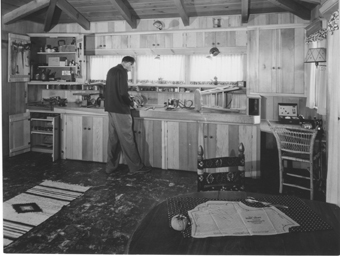
My father in the hobby room
As a child I experienced thirteen different grade schools. My father, a psychologist, was in the military during WWII and we moved a good bit. We settled in the Brentwood hills in Los Angeles when I was eleven and I finished high school there.
During my undergraduate years, at UC Berkeley, at CalTech and at UCLA, I focused on studying chemistry. My thinking was that if I studied chemistry, I would learn physics and mathematics as well. It took me four years to realize my error. Upon graduation from UCLA in 1957 and with fading interest in chemistry I learned that the Ramo Wooldridge Corp. in Redondo Beach, California, was hiring people. Sputnik had just been launched and the US had entered the space race. New hires were being trained to program the computer that was supporting the effort, a Univac. I had seen a computer once and when I learned that the SWAC computer, one of the earliest made, existed at UCLA I had taken the opportunity to learn to use it. So off to Ramo Wooldridge I went.
Five years at Ramo Wooldridge allowed me to do some interesting programming, mostly in octal (the basic language of computers). My first project was to design an operating system for the Univac that would allow the computer to be used continuously. Up to that time the only computer supporting the US space program was brought to a halt while the next programmer loaded his/her deck of cards into the card reader. My work changed that. My second project was to write a symbolic assembly program that would allow programmers to write in alphanumeric code instead of octal. This was prior to Fortran. One of the most exciting experiences of this period was translating my assembler into symbolic code and having the assembler assemble itself. A true feeling of pulling oneself up by the bootstraps. My final project was to design and program a Russian to English language translator using the skills of others who knew the language.
But the yearning to know more and the desire to teach drew me back to graduate school. A friend had taken a theoretical physics degree at UCLA and had talked of a certain professor, Robert Finkelstein. I had heard a lecture by him and I decided that theoretical physics it would be. With great relief, Professor Finkelstein took me on as a student and five years later I had a degree in high energy theoretical physics. My thesis title was Quantization in Clifford Space-Time and Problems in Group Theory. These were wonderful years that I cherish greatly. After a year of teaching as an adjunct professor at UCLA and another year at Northridge State University I discovered that I had another direction to pursue.
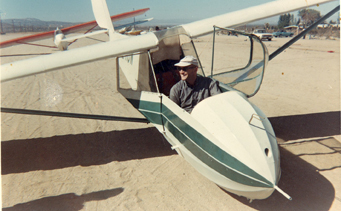
Sitting in the two place trainer at Crystalaire
One wonderful thing about my teaching years was that I had a summer with salary and no commitments. That first summer of freedom I learned to fly gliders and became a glider instructor at Crystalaire in the desert north of Los Angeles. My weekends were spent in the back seat of a Schweitzer 2-22 or 2-32 sail plane taking people for rides and teaching soaring. Sometimes I had time to fly the wonderful 1-26. During this time I accumulated over 1,300 flights in a glider. I also bought a small metal lathe and table saw and plunged into designing a toy battery operated gyroscope. One of my gliding students, David Scott a leather craftsman in Hollywood, taught me the techniques of leather work. These were my early years as a designer.
My first creations in leather were sandals. I had grown up in a home with several chairs made by Giorgio Belloli, an Italian sculptor and architect who lived in Guanajuato, Mexico. His chair designs were in leather and steel. I learned later that Belloli’s chair was very similar to the T-Chair, a design by William Katavolos. I learned later that both designers had lived in Tuscon, AZ about the same time.
I liked the design of the chair and felt that I could improve upon its comfort. My first effort at furniture design was a three legged stool. After completing the stool I realized that by raising one corner high enough to be a backrest I would have a chair. This was the first of my Lotus chairs. From that point on the designs came, one after another. My dining chair became the improvement upon the comfort of the Belloi chair that I had imagined.
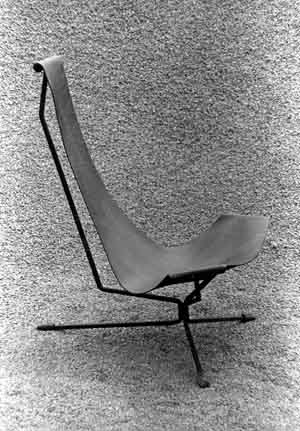
The original large Lotus chair
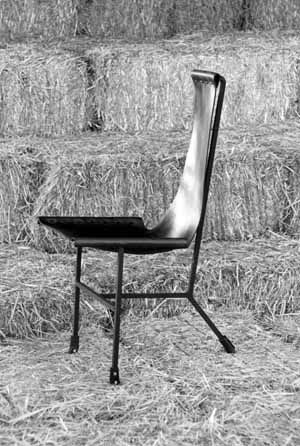
The original dining chair, inspired by the Belloi chair
I began to recognize that the theoretical physics that I had studied was finding its way into my furniture designs. The notions of symmetry theories, perturbation theories and symmetry breaking theories were active influences in the evolution of my work.
The furniture designing continued through 1973 when the comet Kohoutec caught everyone's attention. By this time I was living in a studio in Soquel, California, and had made many of the chair designs that I had envisaged. I wanted to know where to look for the comet. The local university, UCSC, supplied me with the celestial coordinates of its motion but this was of no practical use to me. After some hours I concluded that what I needed was a transparent celestial globe immediately surrounding an Earth globe. With such a device I could plot the celestial coordinates of the comet on the celestial globe and after positioning the two globes based upon the time of day, I would be able to know exactly where to look for the comet.

The UniGlobe, a celestial globe with a terrestrial globe just inside
I set out to make such a device. In the process I learned about vacuum and injection molding of plastics. After three prototypes of what I called the UniGlobe (the name was later trademarked by a travel agency) and writing a user's manual for the device, I had a pretty good understanding of positional astronomy. Using the Uniglobe as a tool, I passed that understanding on to others while teaching celestial navigation on the beach at Santa Cruz Harbor.
While playing with the UniGlobe I realized I could put a pointer on the celestial globe in the current position of the sun along the ecliptic, and by rotating the globe cause the shadow of the pointer to fall back upon itself. At that moment the pointer is pointing directly towards the sun. The relative relationship of the Earth globe to the celestial globe and the use of a rotating time ring around the equator allowed me to tell the current time. I realized that I had made a sundial.
The next step was to simplify the idea. This brought me to the current design of the Wenger Sundial, a clear globe with the Earth's continents and hourly time lines scribed on the surface. The sun's position is determined by causing a shadow of a pointer (for example, a finger or pencil) to fall on the center of the globe. The pointer indicates that spot on the Earth where the sun is directly overhead at that moment and indicates the time via the scribed time lines.
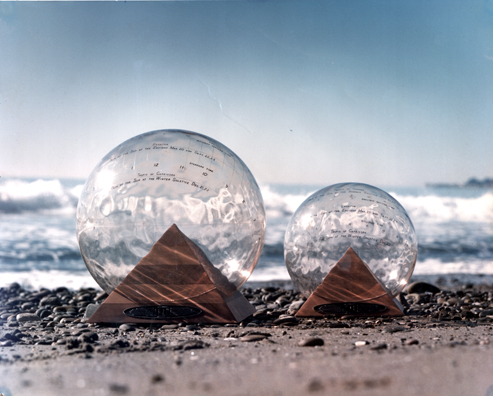
The first sundials, made very much by hand
Using a polycarbonate globe made by a local company, I set out to make my first sundial. Photocopying maps of the world and cutting out sections that were laid on the plastic surface, I traced by hand the outline of the continents and then, using plastic ink, I darkened the lines. My first base was a pyramid. This was a natural object to use for the central pointer and it allowed the proportions of the Great Pyramid to be incorporated into the dial. That pyramid was built with a ratio of height to circumference of 2pi.
The details of the construction of the sundial were documented in my first website which can be found now at WengerSundial.com.

My sundial in San Lorenzo Park, Santa Cruz, CA circa 1975
One of my sundials was placed in San Lorenzo Park in Santa Cruz and enjoyed by many. Unfortunately, vandals destroyed three separate installations of the dial. Another sundial was made for the Lawrence Hall of Science in Berkeley, California. After several years of service that dial too succumbed to vandalism. My days of hand tracing the continents were over. I put the sundial away, but in the back of my mind I knew that the time would come when I would make the sundials in glass. This time did not come for another 26 years. In the meantime, I became interested in the cube.
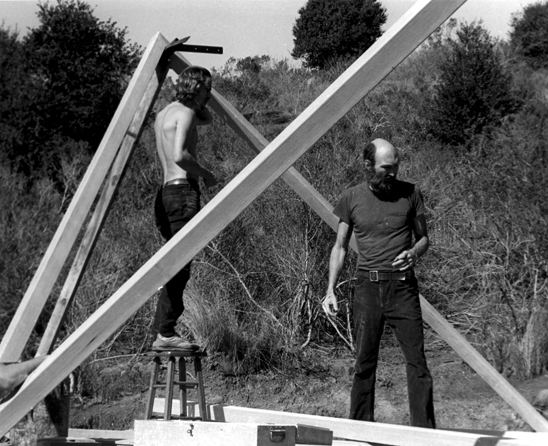
Helping in the construction of a cube home behind Aptos, CA
The cube structure had great interest for me. I had assisted in making several geodesic domes in the 70's and had the opportunity to live in one for some time. The construction process did not appeal to my desire for simplicity. I had made a model of the truncated hexahedron a few years prior and set out to make my first "Cube". Out of 4"x4" fir beams I cut the desired lengths and, with the help of many small temporary supports and with care I began to tie them together. The structure was very unstable until the final diagonal was installed, at which point everything became very stable. After removing the unnecessary supports and installing the final gussets I was left with a beautiful object.
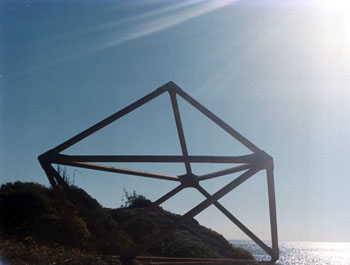
The next step was to design metal brackets that could be attached prior to assembly, brackets that would minimize the time of instability during assembly. My work since leaving my Soquel studio was carried out at SunSeekers Wood Creations, a cooperative woodworking shop at the Old Sash Mill in Santa Cruz. A space became vacant next to the wood shop and I re-established a metal shop called You Name It using tools from my former studio. Many sets of cube brackets were made in the shop. In September, 1979, a Sunset Magazine article about the cube generated widespread interest that still persists. A designer in Russia saw the article and used the idea to design a covered outdoor picnic area at the VDNKh (a large technical park) outside of Moscow. I learned about this use of the design by chance. I was touring the VDNKh in 1983 while on a trip to Russia when I caught sight of the structure and jumped off the tour bus, causing great concern to the tour guide. It was a tremendous thrill to see the cube in Russia.
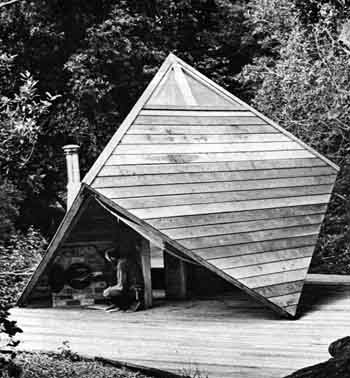
The cube sauna pictured in Sunset Magazine, 1979
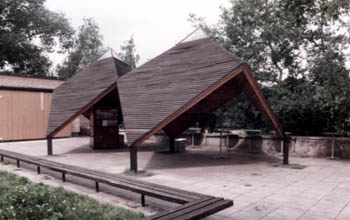
The cube outside of Moscow, Russia, 1983
In 1979 I learned of the Unix operating system and the C programming language which were being broadly used. These marvelous tools drew me back into the computing world. I purchased an early Unix computer (Dual Systems S100) and began to design and create software for myself. During this period I operated, from my home computer in Bonny Doon, one of the first dialup Unix servers in Santa Cruz. I soon turned to consulting in Silicon Valley using my computing and mathematical training. It was not long after that I returned to the academic world. In 1984 I joined the Humanities Division at UCSC and focused my energies on assisting the faculty, staff and students in incorporating computing into their lives.
After fourteen years at UCSC I returned to working for myself and to the design of the Wenger Sundial. Design and construction were carried out in my home studio in Santa Cruz using glass globes and laser scribing methods. During the 26-year interlude, new tools and techniques had been developed that allowed a more modern and exact method of fabrication of the sundial.

The equipment needed to laser etch onto the glass globe of the sundial
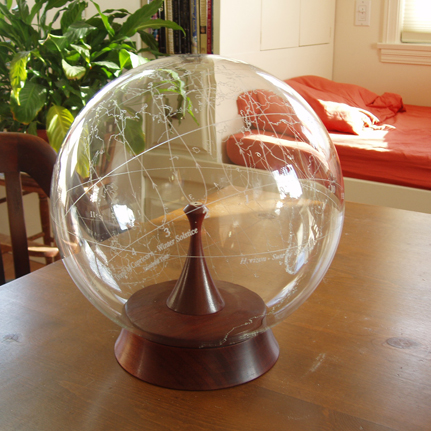
The new glass sundial with detailed continent lines and analemmas
I also returned to the design of the cube using steel instead of wood beams.

The cube with steel beams on display in 2011 in the Museum of Art and History, Santa Cruz, CA
In 2009 I was asked by Scott and Joanna Nadeau, of Ten10 Designs in Los Angeles, to consider making more chairs. I learned at that time that there was an active market in my furniture from the 70s. The mid-century modern look was getting much attention. After some encouragement from my wife I took up the craft again. After a few years on my own I gained the assistance of my son Sam and now we combine our skills as Wenger Designs.
My current interests include design work, genealogy, rock climbing, a passion I acquired in 1999 at the age of 64, sailing, a passion I have had since boyhood, and enjoying my life with my wife, children and grandchildren.

Climbing at Eldorado Canyon, Boulder, Colorado in 2010